
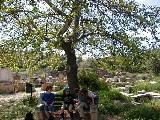
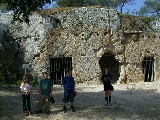
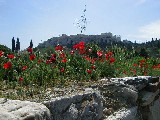 When our party of nine reached Athens we went separate ways during the first couple of days. I tried working in the library Monday but found I was too sick with and medicated for a cold (still very much with me, alas) to concentrate well, and anyhow had little in the way of specific agenda there: I had already adequately researched a problem that next I must simply try to reason out a solution for. On Tuesday Stas and Elizabeth and I and the children went to the National Archaeological Museum, and on Wednesday we all nine hiked over the top of Mousíon or Philopappus Hill, down by Socrates' prison (left), up by the Areopagus, and then down again to the ancient Agora, which was thick with poppies (right, and below).
When our party of nine reached Athens we went separate ways during the first couple of days. I tried working in the library Monday but found I was too sick with and medicated for a cold (still very much with me, alas) to concentrate well, and anyhow had little in the way of specific agenda there: I had already adequately researched a problem that next I must simply try to reason out a solution for. On Tuesday Stas and Elizabeth and I and the children went to the National Archaeological Museum, and on Wednesday we all nine hiked over the top of Mousíon or Philopappus Hill, down by Socrates' prison (left), up by the Areopagus, and then down again to the ancient Agora, which was thick with poppies (right, and below).This morning Paul and Joann left for a week in Crete and Elizabeth and Brendan went home, apparently taking with them the brilliant weather that had persisted throughout their stay with us--today has been very rainy. I rented a car for our tour of the Peloponnese and the Ionian isles, and the first thing I did with it was to ferry all four of them with luggage to the Platía Síndagma, whence there was supposed to be good bus service to the new Athens airport. This airport just opened, something like two days ago, and by all accounts ridiculously prematurely, as the infrastructure for ground transportation to and from the place is nowhere near adequately prepared. (Apparently some ministerial type had rashly staked his credibility and ego on getting the new airport opened and the old one closed before the end of this month.) Add to that the routine problems of a brand-new airport, and the generally confessed national foible of poor organization, and I fully expect to hear horror stories later. At the taverna where we lunched here today, a Greek TV newscast was on without the sound and there appeared to be quite a big segment of airport scenes of frustration and exasperation. We may even have glimpsed ourselves in our rented car in another segment, showing one of two horrific accident scenes we passed on this my first hair-raising day driving in this country.
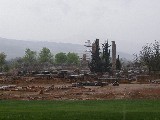 We apparently passed over the Corinth canal on the national highway's bridge without even noticing it in the pouring rain, and made our first Peloponnesian stop a short way beyond at ancient Nemea. This was the site of Heracles' first labor (slaying the monstrous Nemean lion), and of a classical-era sanctuary of Zeus that hosted one of the great pan-Hellenic athletic festivals. Weather was not conducive to our exploring the outdoor site, but there was a very lavish modern museum (built with a foreign donor's money), elaborately housing a collection that perhaps inevitably seemed very thin just days after a visit to the National Archaeological. Particularly nice touches were displays of early nineteenth-century artwork and prose on the ruin of the temple of Zeus; scale models of the site as reconstructed, placed for comparison with the actual site visible out picture windows; and a video segment showing modern re-enactment of the Nemean games, and particularly detailing the ancient starting-gate mechanism for foot races, the hysplex.
This photo of the temple ruin, with three standing columns and architrave bridging two of them (and, alas, some scaffolding), was the best I could manage from the shelter of the museum's eaves. The columns are Doric, but very late classical, dating from the lifetime of Alexander; and they have a slenderness more befitting those of the Ionic or Corinthian orders.
We apparently passed over the Corinth canal on the national highway's bridge without even noticing it in the pouring rain, and made our first Peloponnesian stop a short way beyond at ancient Nemea. This was the site of Heracles' first labor (slaying the monstrous Nemean lion), and of a classical-era sanctuary of Zeus that hosted one of the great pan-Hellenic athletic festivals. Weather was not conducive to our exploring the outdoor site, but there was a very lavish modern museum (built with a foreign donor's money), elaborately housing a collection that perhaps inevitably seemed very thin just days after a visit to the National Archaeological. Particularly nice touches were displays of early nineteenth-century artwork and prose on the ruin of the temple of Zeus; scale models of the site as reconstructed, placed for comparison with the actual site visible out picture windows; and a video segment showing modern re-enactment of the Nemean games, and particularly detailing the ancient starting-gate mechanism for foot races, the hysplex.
This photo of the temple ruin, with three standing columns and architrave bridging two of them (and, alas, some scaffolding), was the best I could manage from the shelter of the museum's eaves. The columns are Doric, but very late classical, dating from the lifetime of Alexander; and they have a slenderness more befitting those of the Ionic or Corinthian orders.
 At the opposite extreme is this temple of Apollo here at Corinth, one of the very oldest such ruins in Greece--pre-classical or archaic in period, sixth century B.C. These monolithic columns are decidely on the stocky side, with extraordinarily wide-flaring capitals up top. It is also the only temple ruin I have seen that is not yet roped off to keep visitors at a little more than arm's length. Some clearly modern graffiti cast doubt on the wisdom of this omission. Now that night is fallen and the temple lit up, and the rain stopped, we find we can see actually see this temple from the rooms we've engaged for two nights.
At the opposite extreme is this temple of Apollo here at Corinth, one of the very oldest such ruins in Greece--pre-classical or archaic in period, sixth century B.C. These monolithic columns are decidely on the stocky side, with extraordinarily wide-flaring capitals up top. It is also the only temple ruin I have seen that is not yet roped off to keep visitors at a little more than arm's length. Some clearly modern graffiti cast doubt on the wisdom of this omission. Now that night is fallen and the temple lit up, and the rain stopped, we find we can see actually see this temple from the rooms we've engaged for two nights.

 Again, the weather made us concentrate most of our time on the site's museum. This was largely full of Roman-era artifacts, which is hardly surprising since the Romans subjected the whole city (except Apollo's temple) to a kind of holocaust in 146 B.C., effectively calculated to cow the rest of Greece into submission. Considering my particular research agenda, I was disappointed to find closed the room of votive sculptures from the local Asclepieion (i.e., the sanctuary of the healer-god Asclepius). Still, there were some choice pieces from Corinth's earlier history. The sphinx at left is of roughly the same archaic date as the temple, while the well-preserved hoplite's helmet at right, appropriately "Corinthian" in style (and curiously suggestive in shape), dates from the beginning of the classical period, the early fifth century B.C., the time of the Persian Wars.
Again, the weather made us concentrate most of our time on the site's museum. This was largely full of Roman-era artifacts, which is hardly surprising since the Romans subjected the whole city (except Apollo's temple) to a kind of holocaust in 146 B.C., effectively calculated to cow the rest of Greece into submission. Considering my particular research agenda, I was disappointed to find closed the room of votive sculptures from the local Asclepieion (i.e., the sanctuary of the healer-god Asclepius). Still, there were some choice pieces from Corinth's earlier history. The sphinx at left is of roughly the same archaic date as the temple, while the well-preserved hoplite's helmet at right, appropriately "Corinthian" in style (and curiously suggestive in shape), dates from the beginning of the classical period, the early fifth century B.C., the time of the Persian Wars.
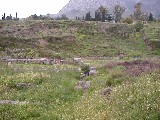 Yesterday dawned promising but turned rainy again. We bought five umbrellas, but even so I got as wet as if I'd been wading up to the knee when I ventured into the overgrown and little visited site of the Corinthian theater and Asclepieion, getting this photo to show their conjunction (an interestingly common phenomenon throughout the ancient Greek world). The Asclepieion is in the foreground, and the hollow in the hillside beyond is the cavea of the theater.
Yesterday dawned promising but turned rainy again. We bought five umbrellas, but even so I got as wet as if I'd been wading up to the knee when I ventured into the overgrown and little visited site of the Corinthian theater and Asclepieion, getting this photo to show their conjunction (an interestingly common phenomenon throughout the ancient Greek world). The Asclepieion is in the foreground, and the hollow in the hillside beyond is the cavea of the theater.
 First was glorious Mycenae, "rich in gold," the citadel of Homer's Agamemnon, and the place (excavated by Schliemann) that gave the late-bronze-age Mycenaean period and civilization their name. Most of the heroic myths of Greece are set in this period, though from Homer on down the extant literature not surprisingly conflates it with later periods in terms of the social, political, and cultural setting. The period more or less ended with the Trojan War, apparently a thoroughly Pyrrhic victory for Mycenaean Greeks. That was as long before the Homeric poems took their present shape as the Spanish Armada was before our own time; and as for Sophocles and Euripides (who both represent nearby Argos as Agamemnon's home, Mycenae no longer being such a going concern in their day), it was as long before their time as the First Crusade--the temporal setting for the Robin Hood legend--was before ours. I had Larissa take this photo of me standing in the famous "Lion Gate," the citadel's massive and well-flanked main entrance, for use in my future lectures, to illustrate its size in relation to the lecturer's. Walls such as these are very typically Mycenaean, and are termed "Cyclopean," reflecting a supposition that only Cyclopes could have had the strength to build them with such massive blocks of stone.
First was glorious Mycenae, "rich in gold," the citadel of Homer's Agamemnon, and the place (excavated by Schliemann) that gave the late-bronze-age Mycenaean period and civilization their name. Most of the heroic myths of Greece are set in this period, though from Homer on down the extant literature not surprisingly conflates it with later periods in terms of the social, political, and cultural setting. The period more or less ended with the Trojan War, apparently a thoroughly Pyrrhic victory for Mycenaean Greeks. That was as long before the Homeric poems took their present shape as the Spanish Armada was before our own time; and as for Sophocles and Euripides (who both represent nearby Argos as Agamemnon's home, Mycenae no longer being such a going concern in their day), it was as long before their time as the First Crusade--the temporal setting for the Robin Hood legend--was before ours. I had Larissa take this photo of me standing in the famous "Lion Gate," the citadel's massive and well-flanked main entrance, for use in my future lectures, to illustrate its size in relation to the lecturer's. Walls such as these are very typically Mycenaean, and are termed "Cyclopean," reflecting a supposition that only Cyclopes could have had the strength to build them with such massive blocks of stone.
 Here at the top of the whole place was the palace; and here my first-born daughter and only son smile for me where Iphigenia and Orestes might once have smiled for their father Agamemnon.
Here at the top of the whole place was the palace; and here my first-born daughter and only son smile for me where Iphigenia and Orestes might once have smiled for their father Agamemnon.
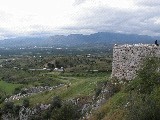 I suspect that Agamemnon's pre-eminence, as primus inter pares among the Achaean chieftains who warred on Troy, had much to do with the plain commanded by his citadel-- one of relatively few places in south or central Greece where there is considerable land that is flat enough to plow.
I suspect that Agamemnon's pre-eminence, as primus inter pares among the Achaean chieftains who warred on Troy, had much to do with the plain commanded by his citadel-- one of relatively few places in south or central Greece where there is considerable land that is flat enough to plow.
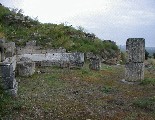
 Next with some difficulty we found our way to the little-visited Argive Heraion, the most important ancient temple and sanctuary of Hera, and a place of well-remembered solitude and profound holiness (especially to married people like us, Hera being goddess of marriage). At left is the fifth-century-B.C. south stoa, and at right the eloquently bare foundation of the archaic Doric temple.
Next with some difficulty we found our way to the little-visited Argive Heraion, the most important ancient temple and sanctuary of Hera, and a place of well-remembered solitude and profound holiness (especially to married people like us, Hera being goddess of marriage). At left is the fifth-century-B.C. south stoa, and at right the eloquently bare foundation of the archaic Doric temple.

 For our third site of the day we stopped at what Homer aptly calls "wall-girt Tiryns," the best-preserved example of a Mycenaean "Cyclopean" walled citadel, and a place that disputes with Thebes the claim to be Heracles' native home. The walls are no longer twenty meters high, but they are still up to eleven meters thick in places.
For our third site of the day we stopped at what Homer aptly calls "wall-girt Tiryns," the best-preserved example of a Mycenaean "Cyclopean" walled citadel, and a place that disputes with Thebes the claim to be Heracles' native home. The walls are no longer twenty meters high, but they are still up to eleven meters thick in places.

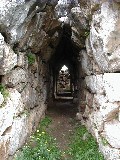 Particularly astonishing is this vaulted gallery, still intact, though now so much feared for that they do not let you go inside any more.
Particularly astonishing is this vaulted gallery, still intact, though now so much feared for that they do not let you go inside any more.
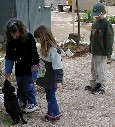
 Incidentally, the children found a friend by the ticket booth, and the poppies were especially plentiful and beautiful throughout the site, wet with the rain (though dusty with their own pollen inside).
Incidentally, the children found a friend by the ticket booth, and the poppies were especially plentiful and beautiful throughout the site, wet with the rain (though dusty with their own pollen inside).